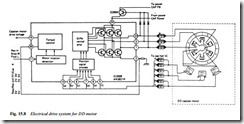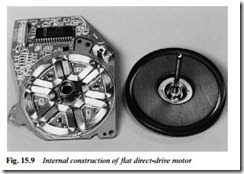SERVO OPERATION IN SEARCH AND STILL MODES
VHS-LP operation involves identical tape and capstan speeds during record and replay, and has little effect on servo operation: the
capstan runs at half normal speed, easily arranged by introducing a ‘×2’ factor in its speed-control loop, or changing counting rate in the speed-control circuit. Where separate head-pairs are provided, the head-drum phasing must be altered to accommodate the difference in the physical positioning of the SP and LP heads on the drum. It is in such ‘trick’ replay modes as still-frame and picture search (cue and review) that servo operation is modified.
In any situation where the tape speed during replay is different to that during record, the angle of the head scan across the video tracks changes, giving rise to horizontal noise bars in the picture at each track-crossing and (especially in cue and review modes) a change in the number of lines per TV field. Non-standard line timing can cause misregistration between luma and chroma components on the TV screen, and loss of line hold if the error exceeds a few per cent. To prevent these effects speed compensation is applied to the drum motor – it is speeded up in cue mode and slowed down during review. These speed offsets are provided by ROM-controlled counter programming.
Trick-speed operation, then, mainly concerns the capstan servo. For cue or review the system control section sets the motor direction according to the command keyed in by the user, then capstan speed is increased by a factor of three or more. To lock the resulting track- crossing noise bars stationary on screen, capstan phase control is referred to suitably divided off-tape control-track pulses.
For still-frame operation the capstan is stopped. In simple video- recorders this will leave a mistracking bar at some random position on the TV screen. For noise-free still frame the capstan stopping point is under close control, determined by the relative positions of the 25 Hz head flip-flop waveform and the noise bar in the replay f.m. envelope. Correct phasing of these two ensures (in conjunction with the wide-head system described in Chapter 13) that the noise occupies the field blanking interval where its effect is nullified by the synthetic field sync pulse generated and inserted into the video waveform at this time, as already described. In some machines the capstan stop- and-shunt motor drive waveforms are generated and timed by a purpose-designed chip, or a microprocessor with suitable built-in ROM. Frame-advance facility is also provided in these cases, for which the capstan motor is stepped on by one track-width for each touch of the advance button, while the position of the noise bar is monitored and corrected each time. Slow-motion is a development of this technique, whereby the capstan motor steps forward very rapidly at short intervals under the control of off-tape control track pulses. New and correctly aligned video tracks are thus presented in the path of the video head sweeps, each remaining in position for many revolutions of the drum before the tape is smartly advanced to display the next field.

